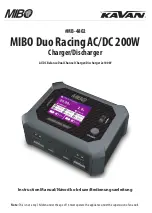
9
English
Refer to Figure 3 and Figure 4 on page 8 before routing or
connecting the power cable and use the following procedure:
1. If the car is not equipped with an internal power supply
connection, route the main power cable’s red and black
leads through the bulkhead and into the engine
compartment. Use an existing opening or, if necessary,
drill a 2 cm (26/32 inch) diameter hole through the
bulkhead. Insert a grommet into the hole to prevent
damage to the power cable. The red and black leads
should be inserted one by one into the hole.
2. Cut the black lead to the desired length and connect it to
the chassis of the vehicle. Verify that the fuse is at a
distance of 20 to 30 cm away from the connection point.
3. On the engine side of the bulkhead, connect the red (A+)
lead to the vehicle’s battery as follows:
a. Cut the long red lead to the desired length, strip the
edge and crimp a terminal lug (not included) to the
lead. Verify that the fuse is at a distance of 20 to 30 cm
away from the connection point.
b. Connect the red lead to the positive (+) terminal on the
vehicle’s battery. Cable tie the wire every 10 cm
(4 inches) along its length.
4. Verify that the cables in the engine compartment do not
obstruct any of the vehicle controls or touch hot or
moveable parts of the engine.
5. For ignition installation, perform the following steps:
a. Cut the long blue lead to the desired length, strip the
edge and crimp a terminal lug (not included) to the
lead. Verify that the fuse is at a distance of 20 to 30 cm
away from the connection point. It is not good practice
to connect the leads to the battery pillars; use the
closest battery connection provided. The Vehicular
Charger/Holder Kit could be damaged if there was a
malfunction in the vehicle’s electrical system.
b. Connect the blue lead to the ignition switch. Verify that
the voltage is high with ignition on, during cranking
and while vehicle is running. When ignition is off, the
voltage is low.
68012009097.book Page 9 Tuesday, May 21, 2013 11:44 AM












































